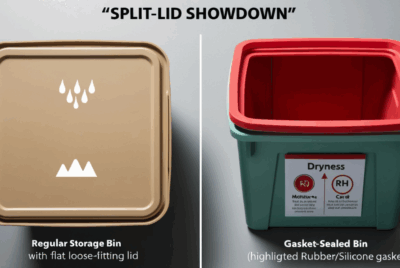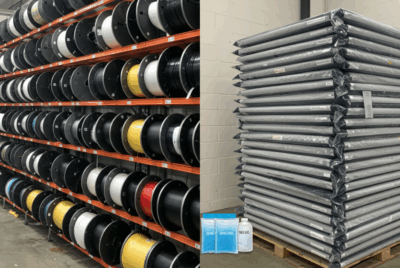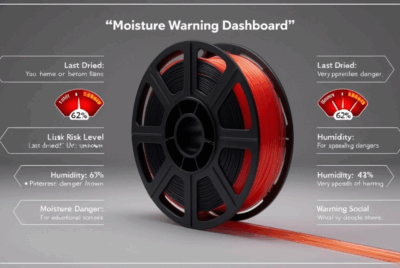Do color additives in filament affect how it should be stored?
1. Is All PLA Really the Same?
You might think every spool of PLA stores the same way—but is that true?
What if one spool is matte black and another is silk gold?
What if one glows in the dark and another contains glitter?
Let’s break down how color additives and visual effects in 3D filament can affect how you store it—and whether you need to treat it differently.
2. What Are Color Additives in Filament?
Colorants (also known as pigments or dyes) are added to base filament materials during manufacturing to give them specific hues or effects.
These additives can include:
- Basic color pigments (red, blue, green, etc.)
- UV-reactive particles
- Glow-in-the-dark compounds
- Silk sheen enhancers
- Carbon fiber, wood, or metal flakes
Some of these are cosmetic—others change the behavior of the filament altogether.
3. Do Colorants Change How Filament Absorbs Moisture?
In most cases, standard color pigments don’t significantly affect hygroscopic behavior.
But filaments with special additives like wood, carbon fiber, or silk tend to:
- Absorb moisture more rapidly
- Become brittle faster
- Lose surface quality if stored poorly
💡 Rule of thumb: the more exotic the look, the more cautious you should be with storage.
4. Are Dark Colors More Stable Than Light Ones?
Yes—in terms of light sensitivity.
- Dark colors (black, navy, forest green) absorb more heat but are less UV-sensitive
- Light colors (white, yellow, pink) can discolor or degrade faster in sunlight or under LEDs
This matters more for long-term shelf storage in open bins or near windows.
5. Does Color Impact UV Resistance During Storage?
Absolutely.
Some filaments are more prone to UV degradation, which can cause:
- Color fading
- Surface chalking
- Weakened layers
Avoid storing brightly colored spools in clear containers near light sources. Use opaque bins or cover spools with fabric or foil.
6. What About Silk, Matte, or Glow-in-the-Dark Filaments?
These are not just pretty. They come with quirks:
- Silk PLA: Often softer and absorbs moisture faster
- Matte PLA: Can be more brittle after exposure to air
- Glow-in-the-dark PLA: Contains phosphors that degrade in light and heat—store in dark, cool bins
Treat these like specialty filaments: dry, dark, sealed.
7. Metallic, Wood-Filled, and Carbon-Fiber Blends
These exotic filaments contain non-plastic particles that make them behave differently.
| Filament Type | Storage Sensitivity | Notes |
|---|---|---|
| Wood-fill PLA | Very high | Absorbs moisture fast |
| Carbon fiber | Moderate to high | Can wick moisture if untreated |
| Metal-fill PLA | High | Prone to tarnish and clumping with humidity |
These should always be vacuum-sealed with fresh desiccant between uses.
8. Storage Risks for Specialty Colors and Effects
- Pearlescent and glitter filaments: Particles can separate if filament degrades
- Transparent/translucent colors: Prone to yellowing or fogging in light
- Neon or UV-reactive filaments: Fading occurs with long light exposure
Keep these in opaque containers and away from windows or fluorescent lights.
9. Should You Store Color-Sensitive Filaments Separately?
Yes—especially if you:
- Use a mix of basic and specialty filaments
- Store some in a dry box and others in vacuum bags
- Want to rotate spools without confusion
Creating a “Specialty Bin” with stronger desiccants, sealed bags, and extra labeling helps keep things safe.
10. Temperature Sensitivity and Color Variants
Believe it or not, some colors can slightly affect temperature behavior.
Example:
- Black PLA might require a few degrees more heat than white PLA
- Silk colors often have lower ideal temps and sag if overheated
So if you’re storing multiple variants together, label temperature guidance clearly so you’re not guessing later.
11. Does Color Affect Shelf Life in Original Packaging?
If sealed, no.
But if exposed to light or air—even for a short time—bright colors and glow materials degrade faster than neutrals.
Best practice? Treat all colored filaments like they’re fragile after the seal is broken.
12. Labeling Colored Filament for Better Storage Tracking
Colored filaments benefit from clear, visual labeling.
Include:
- Material + Color Name
- Special Additive (Glow, Glitter, Silk, etc.)
- Recommended Temp
- Opened Date / Last Dried
- Notes like: “Store in dark bin only”
Helps avoid drying mistakes and storage mix-ups later.
13. How to Prevent Fading and Degradation Over Time
✅ Store in opaque or solid-colored bins
✅ Use vacuum bags with desiccant and UV blockers
✅ Avoid storing near LEDs, windows, or fluorescent lights
✅ Keep in a cool, low-light environment
✅ Rotate infrequently used spools to the back of storage
14. Best Storage Practices for Multi-Color Inventory
If you have a rainbow of spools:
- Group colors by type and sensitivity
- Create a separate bin for special finishes
- Use color-coded labels or tags
- Keep a rotation sheet so older or opened colors get used first
Don’t treat your neon orange glow filament like standard PLA. Keep your inventory smart.
15. Final Thoughts: Storage Is About More Than Just Material
It’s easy to assume filament is all about the material type—PLA, PETG, TPU.
But additives, pigments, and effects all change how it behaves in storage.
So whether you’re storing black PLA or glow-in-the-dark wood-fill, remember:
➡️ Moisture, light, and air don’t care what color it is. But your print results definitely will.
❓FAQs
- Does color really affect filament behavior that much?
Yes—especially with silk, glow, matte, or filled filaments. They store and print differently. - Can glow-in-the-dark filament go “bad”?
Yes. Light exposure can degrade its glow ability, and moisture affects print quality. - Should I keep all filament in the same container?
Not if you’re storing specialty filaments. Use separate bins for sensitive colors or additives. - Can I leave colored filament on the printer for a few days?
For basic colors—yes, if the environment is dry. For silk/glow/matte—best to seal it up after printing. - Do metallic or glitter filaments need special care?
Yes. Store sealed and dry to prevent separation or clumping of particles.




